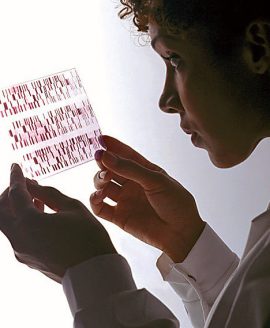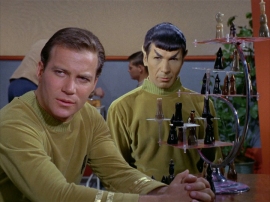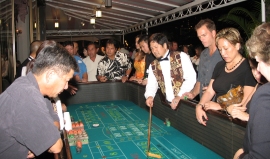
In 1987, Dr. C. Robert Cloninger created the Tridimensional Personality Questionnaire (TPQ). Despite its unique, Star-Trekian name, Cloninger’s TPQ entered a crowded field of personality tests, such as the Myers-Briggs Type Indicator (MBTI), the Enneagram, and the Oxford Capacity Analysis (OCA).

Spock administers the TPQ to Captain Kirk
The TPQ distinguished itself in two respects.
First, it came from a trusted source within the medical establishment. Cloninger, a medical doctor and professor of psychology at Washington University in St. Louis, developed the TPQ from clinical research.
Second, Cloninger’s test made claims about the genetic origin of behavioral differences. Specifically, it argued that important aspects of personality are heritable, that our temperament grows out of genetic factors as much environmental ones.
As Cloninger sees it, the route from gene to expressed behavior follows a path laid down by neurotransmitters, particularly seritonin, norepinephrine, and dopamine. The three dimensions of the TPQ (which measure harm avoidance, reward dependency, and novelty seeking) correspond to different sensitivities in these three neurotransmitters.
Cloninger’s TPQ, now somewhat modified, remains controversial within the field of psychology. Some studies confirm a link between personality assessment and neurotransmitter sensitivity while others do not. In 1996, two studies in the United States and Israel found a correlation between a high proclivity for novelty seeking and a longer sequence in the D4 dopamine receptor gene.
Scientists hypothesized that the added length of the D4Dr sequence made certain individuals particularly sensitive to changes in dopamine. High levels of dopamine — secreted in moments of pain, pleasure, or excitement — would lead to an intense high. By contrast, moderate levels of dopamine would leave the long D4Dr individual feeling depressed.
Novelty seeking, then, was not simply an acting out against one’s parents or the product of a mid-life crisis. It was long-D4Dr individuals’ attempts to self-medicate: to BASE jump, drag race, and free climb their way to their next rush of dopamine.
The discovery of the long D4Dr gene in 1996 captured popular attention. Was exploratory behavior more a matter of genes than life experience? Did Lord Byron chase maids and attack Turks because of a mutation on his 11th chromosome? Was Columbus’s discovery of America an elaborate attempt to get high?
Such genetic arguments are simplistic. Recent studies have brought the TPQ test and the D4Dr-novelty seeking link into question. Moreover, as Maria Coffey points out in her book, Explorers of the Infinite, many of the riskiest activities — such as high altitude mountain climbing – come with long periods of drudgery. If high-risk activity is the key to unlocking an individual’s neuro-chemical Valhalla, the long D4Dr adventurer would do better working as a day-trader on Wall Street or playing the $500 tables in Atlantic City.

What’s more interesting to me is idea that “exploratory behavior” is an impulse beyond our control. This is a distinctly modern idea, though one that expressed itself somewhat differently in the 19th century. At that time, polar explorers called it “Arctic fever” a metaphor that was appropriate for an era afflicted by contagious disease. I find it interesting that late 20th century audiences have placed this impulsive, cannot-be-reasoned-with desire for danger within the human genome.
One might argue that the idea of the D4Dr is rooted in modern scientific research, that it represents something real rather than the 19th century’s metaphor of “fevers.” Still this doesn’t explain why talk of the explorer gene continues today even after the scientific evidence has left it behind.
For example, the dopamine-craving would-be adventurer can still join the D4Dr Club which bills itself as “the ultimate social club for adventure seekers of all types.”
No genetic testing is necessary. If you have an elongated D4DR, you probably know it. Be proud of it! Flaunt it! Whatever your ‘thing’ is – Adventure Travel, Extreme Sports or if you just like an adrenaline rush.
Membership benefits include a newsletter, inclusion in studies about the D4Dr gene, and a discount on flak jackets.












Michael,
Many thanks for an (as ever) engaging post!
But the existence of a “D4Dr club” is dismaying on so many fronts, I hardly know where to start. Like MENSA, that other pernicious group of self-appointed savants, such a group confuses capability or proclivity with action. You may have a genius IQ, good for you, but if you haven’t done something remarkable with that great brain of yours, you are no more worthy of status or accolades than the local village idiot. Similarly, if you have some “explorer” or “risk taker” gene and have done nothing but sit about at home and brag about it, you’re no more notable than an agoraphobe of the accolades of your fellow humans.
The thing that many people understand the least about genetics — including geneticists! — is that 1) Most human human behaviors are of such a high order of complexity that genetic factors are only one of a great many factors influencing actual ability or deeds ; and 2)having a gene for any behavioral quality is only really an indication of potential, not of achievement. As Jonathan Swift once argued, we should not hasten to dub ourselves “Homo Sapiens” (Wise Man) but only “Homo Rationis Capax” (Man capable of reason). To be capable of reason, or of risky undertakings, is not necessarily of itself any cause for elevation.